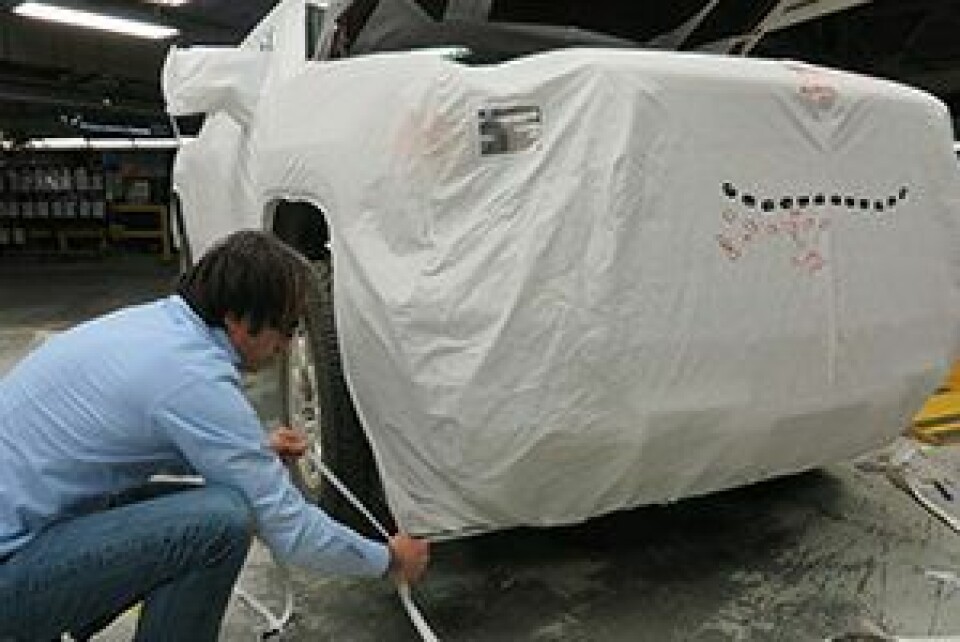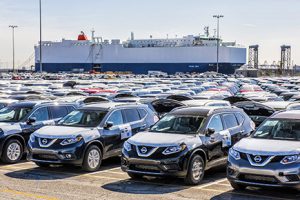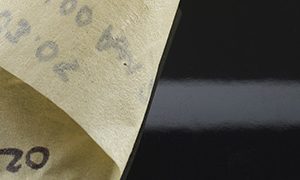Vehicle protection: Trying to cover all bases
 In June this year, upmarket Volvo S90 sedans built at Volvo Cars’ plant in Daqing, northern China, began arriving at a car terminal at the port of Zeebrugge, Belgium for European distribution. Travelling not by sea, but by rail, they are transported in containers across Russia along the China-Europe rail route, three S90s per container, 120 vehicles to a trainload. This rail link cuts the time taken to get vehicles to Europe by two-thirds compared with the usual ocean route, and it has garnered considerable media attention.
In June this year, upmarket Volvo S90 sedans built at Volvo Cars’ plant in Daqing, northern China, began arriving at a car terminal at the port of Zeebrugge, Belgium for European distribution. Travelling not by sea, but by rail, they are transported in containers across Russia along the China-Europe rail route, three S90s per container, 120 vehicles to a trainload. This rail link cuts the time taken to get vehicles to Europe by two-thirds compared with the usual ocean route, and it has garnered considerable media attention.
[in_this_story align="right" border="yes"]Less remarked upon, though, is Volvo’s use of full-body car covers – specifically, fabric-based lightweight covers designed to protect vehicles from environmental damage during shipment. Volvo uses such covers extensively, confirms one of its senior outbound logistics executives. Three years ago, for example, the carmaker started using the covers for distribution in Sweden and Russia. Currently, they are applied to all the company’s vehicle exports from China – even when, as photographs of the shipments highlight, the vehicles in question are travelling in a container. Volvo Cars also ships cars from China to the US by ro-ro vessel.
Volvo isn’t alone in its use of full-body covers. At Emden, Germany-based car terminal operator EVAG, the company’s head of operations Jörg Tuitjer reports that full-body car covers are used for around 30% of vehicle exports moving through the firm’s facilities. Almost entirely handling Volkswagen Group brands, full-body car covers are used for almost all exports to the US, Canada, Japan and Mexico, while film protection is applied for shorter sea journeys such as to the UK. As a rough split, says Tuitjer, full-body car covers are used for 30% of shipments, film for 60% and the remaining 10% of vehicles are protected by part-body covers, protecting the roof, boot (trunk) and bonnet (hood).
In fact, full-body car covers are used by many carmakers, an impressive performance for a protective product technology that has only been in existence for a little over a decade.
Pioneered by Italian manufacturer Confezioni Andrea through its CoverCar operation, production and sales began in Europe before moving to North America in 2013 when the company opened a Michigan sales office, quickly gaining GM as a customer with a contract to supply covers for the export of the 2013 Chevrolet Volt and Opel Ampera, followed by the 2014 Corvette Stingray. The Asian automotive manufacturing market, explains Giovanni Garzone, Confezioni Andrea’s global business development manager, is also covered – if you’ll forgive the pun – through joint ventures.

In 2014, GM announced it would use 100,000 full-body covers from Confezioni Andrea to transport a range of vehicles
Carmakers and logistics providers have made assiduous efforts to reduce vehicle damage in the form of collisions, scratches, knocks and scrapes – particularly while vehicles are being moved or handled by drivers. But environmental damage is a tougher call. Salt spray, sandstorms, acid rain and extreme sun exposure can all literally leave their mark on vehicles, especially when they are left for weeks in a compound, or are travelling long distances for export.
Some form of physical barrier offers obvious benefits, and full-body car covers promise a high degree of protection, while being easier to apply and remove in some ways than various wraps and films.
And yet, such an option is clearly not for everyone. For some brands, hard proof that covers are more effective than targeted films just isn’t there. In North America, for example, both Toyota and Nissan eschew them, even for their luxury brands. These companies tend to prefer more flexible and targeted protection, both for practical and cost reasons.
[sta_anchor id="1"]“We cover the cars in those places where we are experiencing the damage,” says Guillaume Quentin, senior manager for strategy, engineering and quality assurance in supply chain management for finished vehicle logistics at Nissan North America. “Full-body car covers are initially expensive, plastic film less so; it is also more flexible in use, allowing us to protect just what we want to protect,” he states.
Lights, camera, actionBut films are not a straightforward means of protection, either. For example, while the physical cost of film as a protective material is relatively inexpensive – requiring just the polyolofinic, polyethylene or polyurethane film itself, plus adhesive – its application can take 20 minutes, and 6-8 people spread over three assembly line stations. Covers, by contrast, can take just a few minutes to apply.
Furthermore, if the film is not removed within a specified period – typically around six months – the degree of physical attachment formed with the vehicle paintwork risks damage when the film is removed.
That’s why, says Kevin Porter, technical director at protective film specialist Tecman Speciality Materials, a good understanding of both film performance and adhesive characteristics is important. For example, there are six main types of film, and five primary adhesive technologies – but they don’t all work with each other, and ideally the choice of both film and adhesive should be predicated upon the application in question.
“It’s a question of trade-offs, particularly when it comes to curved surfaces,” Porter points out. “A typical polyester film isn’t good at stretching, so for curves you’ll go for a polyethylene or polyurethane film, which does stretch. But then, more conformable films offer less protection, so there’s a temptation to increase the thickness of the film to compensate. That adds cost, as well as a requirement to ensure that the chosen adhesive can then safely secure the film, and still peel off without leaving any residue.
 Some OEMs eschew the use of full-body car covers. In North America, for instance, Nissan says it prefers to use film to cover particular areas
Some OEMs eschew the use of full-body car covers. In North America, for instance, Nissan says it prefers to use film to cover particular areas“It’s really important to think about not just the film but the adhesive,” he adds. “You have to know how adhesives will perform, in terms of residues and ‘witness marks’. Even trying to avoid adhesives altogether by using electrostatic films can result in the films ‘outgassing’ at high temperatures, reacting chemically with the plasticisers in paint lacquers, affecting performance.”
While partial film or physical cover protection is quicker to apply, application can still take up to five minutes, and offers only limited protection – typically protecting the most vulnerable parts of the [sta_anchor id="2"]vehicle from the most commonly encountered forms of environmental damage in a given vehicle lane.
However, damage encountered in one vehicle lane may not be the same as damage encountered in an ensuing lane, such as when fluids drip from an overhead vehicle on a car transporter.
Coverage from top to bottom With that in mind, full-body car covers offer a straightforward proposition, argues Confezioni Andrea’s Garzone: a typical cost of $40 per cover provides a single-use, one-way form of protection. That is not cheap, but it must be seen in context of the quicker application time of four or five minutes and the higher degree of protection.
However, full-body car covers aren’t – if you’ll forgive us once again – a ‘one-size-fits-all’ solution. Market leader Confezioni Andrea’s annual sales are around 1.5m covers per year, excluding Asian joint-venture output. Add in covers from other companies and the total is still just a fraction of the world’s global production of almost 100m vehicles.
While uptake has grown rapidly, use cases – such as at Volvo, Audi, Porsche or Corvette – are concentrated among premium marques. For such models, the $40 cover cost is more likely to be seen as worth the price for protecting brand perception. With Volvo’s rail freight container shipments of the S90, for instance, environmental exposure inside shipping containers is minimal, barring fluid leaks from other vehicles.
Indeed, some carmakers even seem pleased to use customised car covers not only for protection, but also as a form of advertising, especially for cars carried on public roads to or from ports and onward to dealers.
Grant McGlynn, senior manager of supply chain quality at Toyota North America, for example, admits that Toyota’s Lexus division, after seeing other makes in branded covers, enquired with the logistics organisation in the US whether or not it, too, should consider using them.
"Full-body car covers are initially expensive, plastic film less so; it is also more flexible in use, allowing us to protect just what we want to protect." - Guillaume Quentin, Nissan North America
That said, car covers are not exclusive to premium marques. Volkswagen’s Emden exports, for example, include not only premium brands but also more economic Volkswagen brand vehicles, for example. And while customer confidentiality constraints prevent Giovanni Garzone from disclosing specifics, Confezioni Andrea’s full-body car covers are also used to protect everyday models, including those in transport lanes involving more challenging environments.
At GM, the first application of full-body car covers was as a replacement for film in respect of vehicles being shipped along the journey to the Middle East from the US. In a press release issued after GM chose to use the covers in 2014, then-manager of international quality Noel Hunt (who later worked for Confezioni Andrea) said the covers would be used on about 100,000 exported vehicles, including not only premium ones but also Chevy Malibu and full-size pickup and utility vehicles.
According to those close to the issue, there are few hard-and-fast cross-industry rules around using full-body car covers versus film, beyond a broad correlation with premium marques. If anything drives the decision, says James Sadlier, a director at automotive logistics insurance claims agent and risk adviser Sevatas, it is market conditions at the point of delivery, in the destination market.
“It’s not geography so much as the desire by many manufacturers to match quality perceptions to the market,” he notes. “The same European-manufactured small car model is transported with different types of protective coverage depending upon the end users’ geographical location and associated market expectations and standards in those countries.”
[mpu_ad]However, Sadlier adds that these expectations may be more about perception than fact. Modern car-carrying ships pose low risk to cars in ‘normal’ conditions, so the damage-mitigation value of covers for ocean is small, with exceptions. “Rail and road transport involve greater exposure to risks and pollutants, but these can be mitigated with the right approaches, of which car covers are just one aspect,” he notes.
Sadlier says hard evidence to show that full-body car covers reduce damage significantly is difficult to come by; he knows of no large-scale studies of the issue. While individual carmakers may conduct cost-benefit analyses, these are usually restricted to particular models and routes.
[sta_anchor id="2"]“The retrospective analysis of data from a ‘before and after’ scenario seems uncommon across the industry, although some smaller-scale studies have taken place within individual OEMs,” he points out. “For insurers and self-insured OEMs, the benefit of covers comes in regard to catastrophic loss events such as wind storms, airborne pollutants and slight hail; but they do very little in regard to heavier hail, flooding and heavy snowfall.”
Covering the costs?Clouding the issue, say informed insiders, is that full-body car covers are not without incidental costs, above and beyond the cost of procuring, fitting, and eventually disposing of them. One such cost is the driver time entailed at each movement. While covers such as those CoverCar provides to GM allow visibility for drivers, some terminal operators point to more burdensome handling overall for covered vehicles.
[sta_anchor id="3"]“Drivers must open the cover, fix it to the roof, drive the car to the intended location, and then reattach and close the cover – each time that they move the vehicle in question,” says EVAG’s Tuitjer. “That’s why there is a separate price charged for vehicles fitted with covers, because it’s 10-15% slower than handling a car which is not equipped with a cover.”
 Tecman has developed a protective film for ‘piano black’ interior trim, which reduces assembly damage to the high-gloss, black material
Tecman has developed a protective film for ‘piano black’ interior trim, which reduces assembly damage to the high-gloss, black materialAt automotive protective film specialist Tecman Speciality Materials, technical director Kevin Porter’s team is used to working on carmakers’ protection challenges. But perhaps surprisingly, for every exterior protection project that Porter and his team engage on, there are three such interior protection projects.
“Manufacturers are, of course, extremely interested in delivering their cars to the dealers with their expensive interior trim intact, and of course exterior car covers or protective films don’t address that aspect of the journey,” he points out.
The key breakthrough came in carmakers recognising that those very parts which required protection during the shipping process from tier one suppliers to the assembly line were often the same parts that required similar treatment during the outbound delivery journey to the dealer.
The solution? Why not work on applying a film and adhesive combination that could be applied by the parts supplier to not only provide protection during inbound and outbound journeys, but also during the assembly process?
While upscale features such as lacquered walnut trim might be among the more obvious cases in point, others are just as valid, points out Porter.
He highlights the current popularity of an interior trim colour known as ‘piano black’, for example, which is both high-gloss and exceptionally black – a combination that leads to high scrap rates during production as well as to a susceptibility to finger marks and scratches, together with a tendency for conventional film adhesives to leave residues.
No longer, reports Porter. Thanks to the development of a protective film especially for piano black plastic trim, those disadvantages have been eliminated. He reports that the film in question is already in extensive use within Jaguar Land Rover’s supply chain.
There is also the cost of undetected damage: as well as protecting a vehicle, covers also shield it from view, raising the prospect of impact damage lurking undetected under the cover, which is less damage-prone in collisions and knocks than the metal, plastic and glass beneath it.
“It’s a significant and inherent failing of full-body car covers,” says James Sadlier. “All types of cover can hide dents like those caused by slow impact or blunt objects, or ‘door-to-door’ impacts, and these will not necessarily be evident on the cover, with the root cause then also being hidden from liability determination and correction. And as it is the end dealer who will discover the damage, then brand perception becomes a concern, as there has been no opportunity to intercept the vehicle in the logistics chain, a process that many OEMs apply presently.
“For insurers, 90% of damage-prevention effort is correctly placed on handling issues, as these are the day-to-day human-related concerns that can be controlled – as opposed to, say, catastrophic loss – and where only good process, management, attitude and engagement will add value.”
Car cover providers point to the quick application time and damage avoidance, especially for certain transport lanes, to counter the issue of hidden damage. However, it is an issue that has held back the adoption of full-body car covers at some OEMs, including Toyota in North America. According to Grant McGlynn, the carmaker relies on a strict policy of vehicle inspections at every handover point in the finished goods supply chain, with the cost of rectification of any identified damage borne by the appropriate carrier or compound operator.
Toyota’s unrecoverable damage levels are thus low, and any approach that involves obscuring vehicle bodies and making inspections more difficult would be likely to increase them, McGlynn says. Meanwhile, he thinks films are enough for most of Toyota’s unrecoverable damage.
“It’s things like airborne contamination, acid rain, stack ash from vessels lowing their stacks on route, rail dust, and rust particles kicked up during transit – particles that fall from the air and come to rest on a vehicle,” he says. “But our experience is that a protective film on horizontal surfaces can deal with these, and do so far more cheaply. Covers, on the other hand, can be a hassle to deal with – even creating damage during fitting and removal – and can also cover up a lot of damage.”
 Volkswagen Group uses full-body car covers on exports from the port of Emden for a range of vehicles across the group including VW, Audi and Porsche models
Volkswagen Group uses full-body car covers on exports from the port of Emden for a range of vehicles across the group including VW, Audi and Porsche modelsToyota has taken into account a variety of factors, including the interest from Lexus in using the covers as advertising. But the economics just didn’t stack up, explains McGlynn, who led the cost-benefit analysis study three years ago.
“There were savings, but insufficient savings in relation to the cost of the covers,” he sums up. “From a marketing point of view, the fancy signage might have been attractive, but there really wasn’t a business case.”
Choose your favourite cover versionA similar story comes from Nissan Group of North America, where cost-benefit analysis of full-body car covers reached a comparable conclusion – although the company has left the door open for some journeys for more expensive models.
“In the end, we weren’t able to adequately articulate the additional benefits [for Nissan in the US], despite other regions of the Renault-Nissan Alliance finding that covers worked for them,” explains Guillaume Quentin, who worked previously in Europe at Renault, where the brand uses covers to ship vehicles from Europe to Asia.
“Nissan concluded that it is so far not cheaper compared to current processes and damage levels to justify a change, but that there might be a need in the case of damage-prone longer journeys, or high-end vehicles.”
In Nissan’s view, damage is correlated with journey distance, which is why Japanese-manufactured vehicles receive more protection than those built in the US. But in each case, the protection is not only proportionate to the damage incurred, but targeted on protecting proven areas of risk – like paint guard film (PGF) on flat surfaces or contact-prone areas.
Currently, it would seem that the use of full-body car covers comes down to individual carmaker preferences rather than hard-and-fast rules, or data-driven decision-making. On the one hand, at the likes of Nissan and Toyota, the cost-benefit proposition is unclear, despite long sea journeys and a product mix containing upscale models; on the other hand, there is Volkswagen Group and especially Volvo Cars, which uses covers even for container-shipped vehicles.
[related_topics align="right" border="yes"]“Car manufacturers appear to be the primary initiator for the adoption of car covers, but are driven in [sta_anchor id="4"]response to past losses, market expectations and any perceived competitive advantage this may bring them,” sums up James Sadlier. “But these are not readily quantified and are dependent on market norms and the perceived advantages from promoting quality, which we see in countries such as Japan, where imports are often heavily protected even for volume models.
“In terms of how the costs and benefits of full-body car covers stack up, it really is in the eye of the beholder.”
 Talk to almost anyone in the finished vehicle logistics industry, and a fairly consistent view of film protection emerges: while film itself is relatively inexpensive, the application requires cost, time and space. Less manual applications are possible, but generally at the cost of lower protection and usually with less surface area of the car being protected.
Talk to almost anyone in the finished vehicle logistics industry, and a fairly consistent view of film protection emerges: while film itself is relatively inexpensive, the application requires cost, time and space. Less manual applications are possible, but generally at the cost of lower protection and usually with less surface area of the car being protected.
But suppose it were possible to apply the film not as a finished plastic, but as a spray. What might that do to the equation?
Brent Frederick, senior sales engineer for dispensing systems at French-owned spray paint technology specialist Sames-Kremlin, whose spray booth and robotic sprayers are a common sight in car plants, has an answer.
He believes that by using what Sames-Kremlin calls ‘liquid-applied transit coating’ to vehicles immediately after their bodies have left the plant’s paintshop (but before assembly), savings of around $1m a year per car plant might be expected. Critically, these come from lower damage levels during vehicle shipment to final destinations and reduced damage during assembly in the production plant itself – a source that Sames-Kremlin’s automotive customers reckon to be their overall largest issue, outstripping transit damage.
“The material cost is equivalent to conventional film, but the capital cost of the application process, relative to the cost of employing people on the line and coupled to the improved performance, delivers a two-year return,” says Frederick, adding that the process – developed by Sames-Kremlin in response to a specific North American carmaker’s request – is currently being either evaluated or implemented by four global OEMs.





